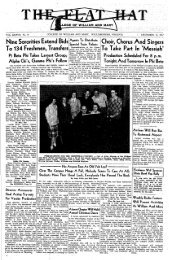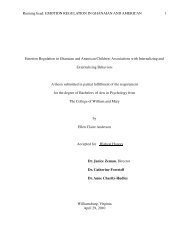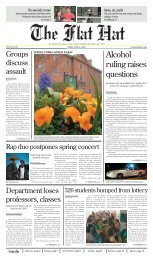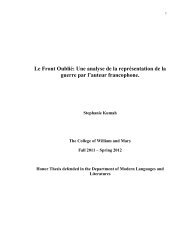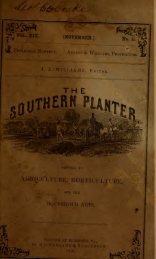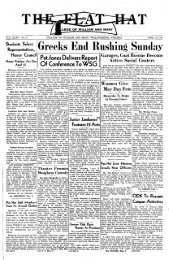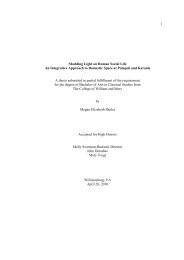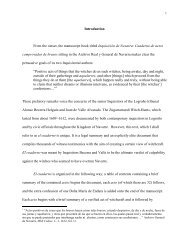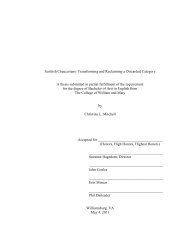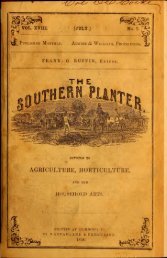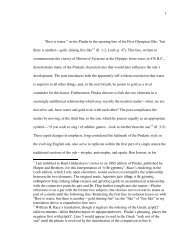Southern planter - The W&M Digital Archive
Southern planter - The W&M Digital Archive
Southern planter - The W&M Digital Archive
You also want an ePaper? Increase the reach of your titles
YUMPU automatically turns print PDFs into web optimized ePapers that Google loves.
438 THE SOUTHERN PLANTER. [July<br />
produce a dog, a bitch produce a lamb,<br />
&c. ; but it must be accompanied in our<br />
mind with another law, tho law of varia-<br />
tion. <strong>The</strong> child is not always like its parent<br />
in every respect, and sometimes not<br />
like its species, as when a lamb has two<br />
heads or six legs, &c, as we often find.<br />
<strong>The</strong>n we call it a monster. This diversity<br />
forms the problem of hereditary influence,<br />
and it is for the causes of, and reasons for,<br />
the variation that the breeder must en-<br />
quire, and make himself acquainted with,<br />
so that he may, as far as possible, modify<br />
them. One of the causes of variation is<br />
what is called " breeding back." It is of-<br />
ten a source of disappointment to the<br />
breeder that when he puts a well-formed<br />
female and a well-formed male, he gets an<br />
ill-formed colt or calf, and of quite a differ-<br />
ent colour to what he expected. If you enquire<br />
into the pedigree of the parents you<br />
will find the child answering in every re-<br />
spect to the description of an ancestor.<br />
This is the law of atavism. It is this that<br />
makes many say that horse-breeding is a<br />
lottery. However, if you breed properly<br />
you have little to fear. Pure and thoroughbred<br />
animals comparatively seldom breed<br />
back, or disappoint their owners in doing<br />
so. By thorough-bred is meant those<br />
whose ancestors were for a long time of<br />
the same shape, and adapted for the same<br />
purpose as themselves. <strong>The</strong> more the animals<br />
have been crossed the more subject<br />
are they to breed back, and more the dif-<br />
ference in shape in crossing the more likely<br />
is breeding back to prove a disappointment.<br />
A case was related to illustrate this law.<br />
How is it to be explained ? <strong>The</strong> " Westminster<br />
Review" very properly says, " It<br />
is to be explained on the supposition that<br />
the qualities were transmitted from the<br />
grandfather to the father (the other sex<br />
may convey it equally well,) in whom they<br />
remain latent or were marked by the presence<br />
of some antagonistic or controlling in-<br />
fluence, and thence transmitted to the son,<br />
in whom the antagonistic influence being<br />
withdrawn they manifest themselves. Mr.<br />
Singer, let us say, has a remarkable aptitude<br />
for music, but the influence of Mrs.<br />
Singer is such that the children, inheriting<br />
her imperfect ear, manifest no musical talent<br />
whatever. <strong>The</strong>se children, however, have<br />
inherited the disposition of their father in<br />
spite of its non-manifestation ; and if, when<br />
they transmit what in them is latent, the<br />
influence of their wives is favourable, the<br />
grand-children may turn out musically<br />
gifted. In the same way consumption or<br />
insanity and other hereditary diseases seem<br />
to lie dormant for a generation or more,<br />
and in the next flashes out with the same<br />
fury as of old." This should make you<br />
very careful in breeding stock, and to as-<br />
certain that not only the sire and dam are<br />
free from spavin, curbs, &c, but that their<br />
ancestors were not subject to any hereditary<br />
affection, and not only that they were<br />
free from hereditary evils, but that they<br />
possess the same good qualities, and are<br />
adapted for the same purpose as them-<br />
selves. Several very beautiful, instructive,<br />
and interesting illustrations were produced<br />
to prove that diseases arising from accident,<br />
as well as constitutional idiosyncracy, curious<br />
tricks, acquired habits, vicious and peevish<br />
tempers, as well as good tempers, &c, were he-<br />
reditary, or transmissible from parent to off-<br />
spring. Now comes the vexed question,<br />
" Which has the predominating influence on<br />
the progeny, the male or the female parent ?<br />
If both parents join to form the child, does<br />
the parent give one group of organs and<br />
the other parent another group; or do both<br />
give all ?" This subject is so very inter-<br />
esting, and it is so important, that the<br />
breeder should come to some definite con-<br />
clusion upon it, that he felt justified in occupying<br />
a considerable part of their time<br />
in its investigation. Several great men<br />
were mentioned who maintain that the male<br />
parent furnishes the external configuration,<br />
or, in other words, the locomotive organs<br />
while the female parent gives the internal<br />
or vital organs, each absolutely independent<br />
of the other. Other equally celebrated ob-<br />
servers declare that it is quite the reverse,<br />
the female preponderates always in the locomotive<br />
organs, and the male in the vital<br />
organs. Others again, equally as eminent,<br />
assert that both theories are wrong ; that<br />
the male always gives external configuration<br />
or locomotive organs, and the female<br />
the internal or vital organs, but do not mean<br />
it to be inferred that either parent gives<br />
either set of organs uninfluenced by the<br />
other parent, but merely that the leading<br />
characteristics and qualities of both sets of<br />
qualities are due to the male on the one<br />
side and to the female on the other, the<br />
opposite parent modifying them only. He<br />
(Mr. Evans) believed they were all wrong<br />
—that the truth lies between them. He



